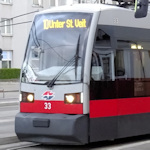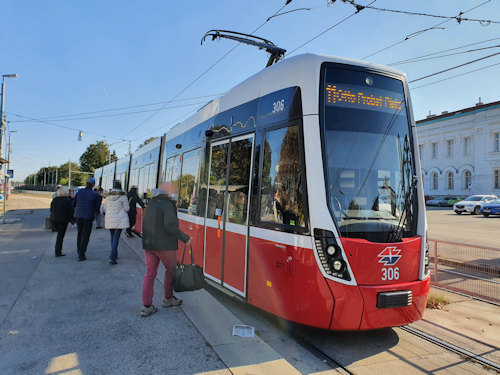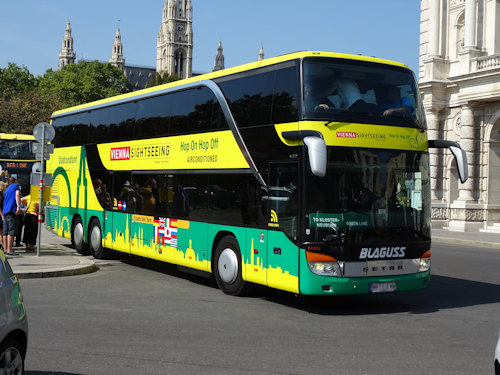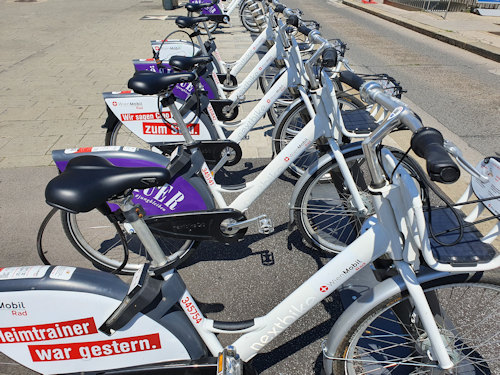
Discover how best to get around Vienna and whether you’ll be needing sunscreen or snow shoes while you do.
- Find a guided city tour* for your trip
- See also:
- Intro to Vienna (includes an overview of the city’s layout from a visitor perspective)
- Vienna Welcome Card (network travel pass + discounts)
- Vienna City Card (ditto)
- Vienna Pass (sightseeing pass with optional network travel add on)
Jump to:
- Public transport
- Airport connections
- Sightseeing tours
- Using your feet
- Using a bicycle
- Using a car
- Weather
Public transport

(One of our sleek new trams)
Most tourists (and locals) rely on the fantastic municipal transport system for travelling from A to B in Vienna, so let us begin here…
A network of buses, city trains, trams and subway lines operate through a remarkably cheap, clean, frequent and reliable public transport system.
Most visitors end up shaking their heads in disbelief at the efficiency and at how little you have to pay for that efficiency. Learn how the tickets work and how to understand the signs at a tram stop.
The system is very wheelchair-friendly, too, with lifts at almost every subway station, many step-free trams, etc.
Tip: a number of city passes designed for visitors include a public transport component.
Airport connections

(This way to your flight)
Vienna International Airport lies just beyond the city limits, so is not covered automatically by standard city network cards, for example.
Of course, being an airport, it’s (obviously) still hooked up conveniently to road, rail, and bus systems.
Discover all you need to know about getting to the airport from Vienna and getting to Vienna from the airport.
For the record, trains from central stations get you there or back in as little as 16 minutes. And a car journey to/from the centre can take under 30 minutes in good traffic. (Though traffic through the city centre can rarely be described as good.)
Sightseeing tours

(One of our hop on hop off buses)
For city-wide sightseeing routes, try one of the two popular hop on hop off bus services or a hybrid bus and virtual reality tour.
As you might expect, Vienna also has numerous other kinds of tours, including themed walking tours and boat trips on bits of the Danube.
Using your feet

(Starting point for my recommended self-guided tour)
Vienna has many places of interest for tourists, but five main sightseeing areas stand out, which you’ll find here. As mentioned above, you can also explore the city on a suitable walking tour).
You have 23 Vienna districts to discover in total, and the city provides a useful online map for residents and visitors alike (or just use Google, of course).
The small size of the historical centre (essentially the first district) makes it easy enough to walk around, but with Viennese driving habits you might need some tips on how to cross the road safely.
And Vienna has some rather funky pedestrian lights.
Using your bicycle

(Plenty of bikes for hire)
Vienna has come on leaps and bounds in recent years in terms of making the city more cyclist friendly.
This overview page has details of the hundreds of miles of cycle paths and lanes in the city, and introduces you to the network of unmanned bike hire stations.
Using your car

(Vienna sits on major routes to the south, east and west)
For helpful hints on local driving habits and regulations, check the driving in Vienna page.
Learn, for example, where to park, how to pay the motorway toll, what the mysterious Rettungsgasse is, and why trams are not necessarily your friend on the road (they’re bigger than you and they have precedence).
Weather

(The Karlskirche church in winter)
Vienna enjoys a relatively pleasant climate where the summers are warm and dry, the winters crisp and cold (though I can’t help but feel they’re getting warmer).
The climate even means Vienna has its own flourishing wine-growing industry. But don’t let that fool you into thinking the chillier seasons are Mediterranean.
Get an overview of the monthly weather to help plan which clothes to bring for a trip and decide on the best time to visit Vienna. If you come in deep midwinter, pack emergency flares, thick socks and a portable heater (just kidding, especially with climate change).
If you arrive in a summer heatwave, then consider some of these locations and activities to stay cool.
Oh, and if you’re visiting at the end of December, you probably want the answer to this question: does it snow at Christmas? (Spoiler: sadly, probably not. But you never know.)